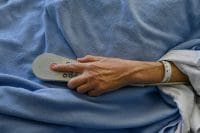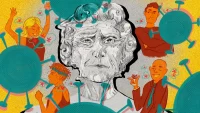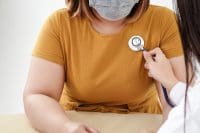My name is Samantha and I’m 22-year-old ICU nurse. Many people tell me how accomplished I am for my age—how amazing it is that I take care of individuals when they are critically ill. But the year is 2021. COVID-19 is taking the lives of people of all ethnicities and ages. If you don’t work directly with these patients, you don’t understand what those delivering care are experiencing. For example, you don’t understand what it means to gown-up in several layers (making you hot and uncomfortable) for many hours, only to have your efforts be futile.
I’m writing this to help others understand, so they catch a glimpse at what it continues to be like during these perilous times, what it’s like to watch fellow nurses suffer from PTSD, what it’s like to have to start taking antidepressants in order to go to work, and most importantly what it’s like to work with patients suffering from COVID-19.
In the ICU, we work 12-hour shifts. That’s 12 hours of donning and doffing personal protective equipment. Most of us try to work several days in a row so we can have several days in a row off. Once our work days are over, we spend the rest of the week recouping and trying to remember why we chose the career we chose.
I took care of Mateo* for four days in a row. He was a 47-year-old Hispanic man with a medical history of diabetes, retinopathy, and nephropathy—a combination that allowed the coronavirus to thrive. Mateo came to the hospital because of difficulty breathing, decreased appetite, and general malaise. He tested positive for COVID-19 and required intubation for respiratory failure soon after his arrival to the hospital.
Day 1
When I first meet Mateo, he’s intubated, sedated with fentanyl and midazolam, and subsequently receives levophed for low blood pressure. Despite sedation, Mateo is fighting the ventilator. The provider orders cisatracurium, a paralyzing agent, and adds propofol for sedation.
Mateo’s oxygen saturation increases, and we obtain an arterial blood gas (ABG). The ABG will tell us his P/F ratio—the key number is 150. If this number is above 150, Mateo will remain supine, on his back; if less than 150, the providers will determine if we should flip him on his belly, in other words “prone” him. Mateo’s P/F ratio is 68. The providers decide on the prone position, which studies have shown can help increase oxygenation.
Now I need to find six more nurses and the respiratory therapist to help me flip Mateo to the prone position. I need to pull those six nurses away from their own critically ill patients. Once everything is in order, we make the flip. Mateo responds well to proning; 1 hour later, his P/F ratio rises to 133—not 150, but at least improving. I look up at the clock to find that the 12 hours of my shift are done; it’s time to give report and go home to refresh before coming back the next day.
Day 2
My alarm goes off at 5:45 AM. When I arrive in the ICU, Mateo’s nurse on the previous shift tells me his morning blood work results show a potassium of 6.3 mEq/L. (Normal is 3.5-5.5 mEq/L.) The provider thinks it’s a mistake, so I redraw the blood. The result is a potassium of 6.6 mEq/L—the high potassium is getting higher and is very real. The orders rush in, starting with promptly turning Mateo from the prone to the supine position. Six nurses and the respiratory therapist run into the room to help me flip Mr. Castillo. I give a variety of medications—sodium polystyrene sulfate, insulin, and dextrose.
Now it’s time to consult renal providers. With such high potassium levels and poor urine output, Mateo needs dialysis. The nephrologist decides on continuous veno-venous hemofiltration (CVVH), a type of dialysis that’s less harsh than regular hemodialysis. CVVH requires two nurses to set up the machine, and I have to check the machine hourly, making adjustments as needed based on factors such as Mateo’s hourly fluid intake and urine output. By the end of the day, Mateo is on CVVH and receiving fentanyl, midazolam, cisatracurium, propofol, antibiotics, and tube feedings. I give report and head home.
Day 3
Mateo’s condition is steady. Research shows that the coronavirus puts people at risk for blood clots. Since CVVH filters blood, it also removes the clots, but if too many clots group in the filter, the machine will malfunction, possibly causing Mateo to lose all the blood that is in the process of being filtered. At 7 AM, I see that the filter has numerous clots, so I do an emergency return of blood: I reset the CVVH machine and begin running it again with a fresh cartridge. Mateo is also receiving a heparin infusion to help stop his blood from clotting.
Day 4
Mateo is showing great improvement. After 7 AM rounds, the providers decide to stop the cisatracurium, lower sedation, and try to get Mateo to wake up. As I begin to decrease the fentanyl, propofol, and midazolam, Mateo becomes tachycardic with a heart rate in the 150s (beats per minute), hypotensive with a systolic blood pressure in the 70s (systolic), and hypoxic with an oxygen saturation of 84%. The providers increase sedation and adjust ventilator settings.
Those adjustments help stabilize Mateo until 5:30 PM. His heart rate is again in the 150s, his blood pressure begins to drop, and despite being placed on 100% of oxygen, his oxygen saturation is in the 70s%. Stat orders pop up on my computer screen: ABG, x-ray, laboratory tests, cisatracurium I.V. bolus, adenosine I.V. push to reduce heart rate, and many more. X-ray and ABG show little to no change. The cisatracurium bolus and adenosine have no significant effect. With the laboratory results pending, 7 PM appears on the clock; it’s time for me to give report and return home.
The news
At 8 AM the next morning, my phone alerts me to a text from a friend at work: “242 died”. Tears roll down my face. How could I have worked so hard to save his life and yet he died anyway? Why did I sweat for hours, along with other colleagues, just for nothing to work? Why do I do the job that I do?
These are the questions we continue to ask ourselves every day. How is it that a normal, healthy middle-aged man died from COVID-19? Did we miss something? Did I miss something?
But you don’t have time to ponder these questions because the next “Mateo” is rolling in the door. There is no break. The next COVID-19 patient might be younger, older, taller, or different from the one you just cared for, but you need to give the same effort again. The same heart needs to go into every patient, and yet too many times that patient isn’t going to make it. “Keep pushing, it will get better”: That’s what we hear from family members, other hospital staff, and the general population. But the sad reality is that it probably won’t, and that takes a toll on a nurse’s mental health. Yet nurses like me go to work each day because that is our obligation.
So, where does that leave us? Since I was a little girl, I always wanted to help others by becoming a nurse. But after less than a year, I’ve never been more sure that I can’t do critical care nursing for the rest of my life. I’m young and privileged enough that I return to school and become a family nurse practitioner so I can help others from the preventative side of care. But what about those who don’t have that option?
I’m lucky to have experienced critical care nursing and to be granted a job that provided me with such great insights and the opportunity to work alongside some of the best nurses. I hope sharing my experience can help provide my fellow nurses and healthcare workers with a voice.
The job needs to be done, but at what expense and what can we do to help support those doing that job?
*Name is fictitious.
Samantha Ellis is a staff nurse at UMass Memorial in Worcester, Massachusetts.
Nurses can access free resources for supporting their mental health at the Well-Being Initiative Website.


















